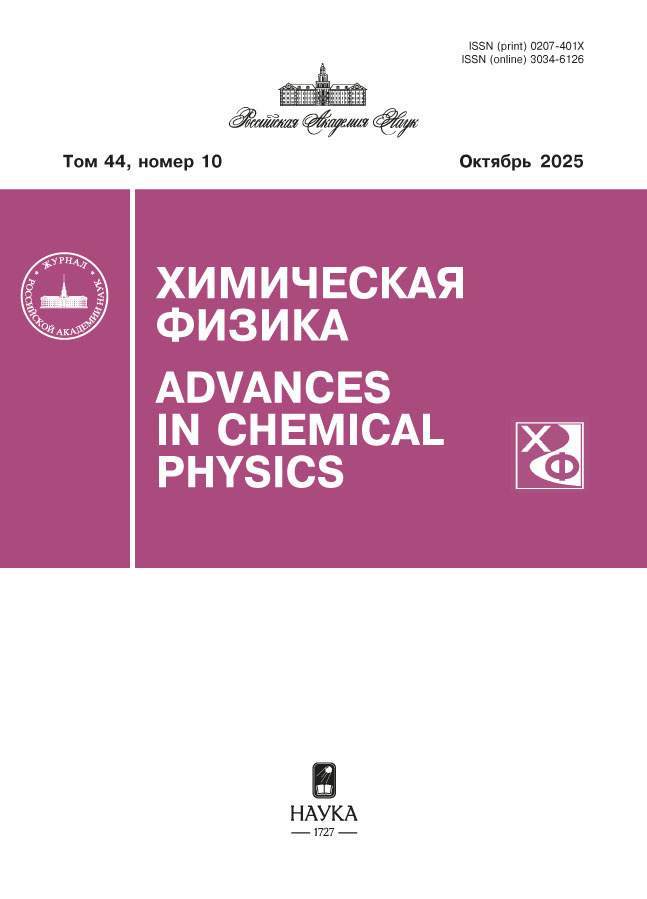Measurement of the electron concentration in the vicinity of a strong shock wave
- Authors: Kozlov P.V.1, Gerasimov G.Y.1, Levashov V.Y.1, Bykova N.G.1, Zabelinsky I.E.1, Kotov M.A.2
-
Affiliations:
- Institute of Mechanics, Lomonosov Moscow State University
- Ishlinsky Institute for Problems in Mechanics, RAS
- Issue: Vol 43, No 6 (2024)
- Pages: 25-32
- Section: Combustion, explosion and shock waves
- URL: https://cardiosomatics.orscience.ru/0207-401X/article/view/674933
- DOI: https://doi.org/10.31857/S0207401X24060034
- ID: 674933
Cite item
Abstract
A series of probe measurements to determine the electron concentration in a gas ahead of a strong shock wave front was carried out using a double-diaphragm shock tube DDST-M of the Institute of Mechanics, Moscow State University. At the same time, the light flux from the region of the shock-heated gas was recorded, which made it possible to calculate the electron concentration behind the shock wave using the spectroscopic method. The experiments were carried out in air, oxygen, and nitrogen at shock wave velocities from 8.3 to 11.3 km/s and an initial pressure of 0.25 Torr in the low-pressure chamber. The dependences of the electron concentration on the shock wave velocity and the distance from the observation point to the shock wave are obtained. Spectroscopic measurements made it possible to determine the dependence of the electron concentration on the composition of the gaseous medium. The obtained data are compared with the experimental data of other authors.
Full Text
About the authors
P. V. Kozlov
Institute of Mechanics, Lomonosov Moscow State University
Email: vyl69@mail.ru
Russian Federation, Moscow
G. Ya. Gerasimov
Institute of Mechanics, Lomonosov Moscow State University
Email: vyl69@mail.ru
Russian Federation, Moscow
V. Yu. Levashov
Institute of Mechanics, Lomonosov Moscow State University
Author for correspondence.
Email: vyl69@mail.ru
Russian Federation, Moscow
N. G. Bykova
Institute of Mechanics, Lomonosov Moscow State University
Email: vyl69@mail.ru
Russian Federation, Moscow
I. E. Zabelinsky
Institute of Mechanics, Lomonosov Moscow State University
Email: vyl69@mail.ru
Russian Federation, Moscow
M. A. Kotov
Ishlinsky Institute for Problems in Mechanics, RAS
Email: vyl69@mail.ru
Russian Federation, Moscow
References
- Surzhikov S.T. // Rus. J. Phys. Chem. B 2010. V. 4. P. 613.
- Bykova N.G., Gochelashvily K.S., Karfidov D.M. et al. // Appl. Optics. 2017. V. 56. P. 2597.
- Golubkov G.V., Manzhelii M.I., Berlin A.A. et al. // Rus. J. Phys. Chem. 2021. V. 15. P. 362.
- Golubkov G.V., Berlin A.A., Dyakov Y.A. et al. // Rus. J. Phys. Chem. B 2023. V. 17. P. 1216.
- Stupochenko Y.V., Losev S.A., Osipov A.I. Relaxation in Shock Waves. Springer, New York, 1967).
- Lochte-Holtgreven W. Plasma Diagnostics. Willey, New York, 1968.
- Zel’dovich Y.B., Raizer Y.P. Physics of Shock Waves and High Temperature Hydrodynamic Phenomena, 3rd ed. Dover Publ., New York, 2002.
- Alekseev B.V., Kotelnikov V.A. Probe method for plasma diagnostics. Energoatomizdat, Moscow, 1988.
- Demidov V.I., Kolokolov N.B., Kudryavtsev A.A. Probe methods for studying low-temperature plasma. Energoatomizdat, Moscow, 1996.
- Gorelov V.A., Kildiushova L.A., Chernyshov V.M. // TsAGI Sci. 1977. V. 8. № 6. P. 49.
- Fujita K., Sato S., Abe T., Matsuda A. AIAA Paper. 2018. No. 2002-2765.
- Nomura S., Lemal A., Kawakami T., Fujita K. AIAA Paper. 2018. No. 2018-0741.
- Golant V.E. Microwave methods for plasma research. Nauka: Moscow, 1968.
- Vlasov P.A., Karasevich Yu.K., Pankrat’eva I.L., Polyansky V.A. // Phys.-Chem. Kinet. Gaz. Dynam. 2008. V. 6. № 1. P. 1.
- Gorelov V.A., Kireev A.Yu. // Phys.-Chem. Kinet. Gaz. Dynam. 2014. V. 15. № 1. P. 1.
- Cruden B.A. // J. Thermophys. Heat Transf. 2012. V. 26. P. 222.
- Kotov M.A., Kozlov P.V., Osipenko K.Yu., Gerasimov G.Ya., Levashov V.Yu., Bykova N.G., Zabelinsky I.E. // Rus. J. Phys. Chem. 2023. V. 17. P. 977.
- Zabelinsky I.E., Kozlov P.V., Akimov Yu.V. et al. // Rus. J. Phys. Chem. 2021. V. 15. P. 977.
- Hassouba M.A., Galaly A.R., Rashed U.M. // Plasma Phys. Rep. 2013. V. 39. P. 255.
- Nomura S., Kawakami T., Fujita K. // J. Thermophys. Heat Transf. 2021. V. 35. P. 518.
- Kozlov P.V., Surzhikov S.T. AIAA Paper. 2017. No. 2017-0157.
- Heays A.N., Bosman A.D., van Dishoeck E.F. // A&A. 2017. V. 602. P. A105.
- Katsurayama H., Matsuda A., Abe T. AIAA Paper. 2007. No. 2007-4552.
- Surzhikov S.T. // Phys.-Chem. Kinet. Gaz. Dynam. 2022. V. 24. № 4. P. 1.
- Lemal A., Nomura S., Fujita K. Hypersonic Meteoroid Entry Physics. IOP Publ. 2019. P. 9–1.
- Omura M., Presley L.L. // AIAA J. 1969. V. 7. P. 2363.
- Gorelov V.A., Kildushova L.A., Kireev A.Yu. AIAA Paper. 1994. No. 1994-2051.
- Gigosos M.A., Gonzalez M.A., Cardenoso V. // Spectrochim. Acta Part B: Atom. Spectrosc. 2003. V. 58. P. 1489.
Supplementary files


















